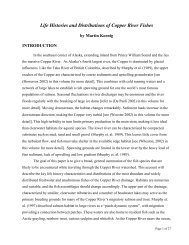Mitigation for the Construction and Operation of Libby Dam
Mitigation for the Construction and Operation of Libby Dam
Mitigation for the Construction and Operation of Libby Dam
You also want an ePaper? Increase the reach of your titles
YUMPU automatically turns print PDFs into web optimized ePapers that Google loves.
The <strong>Libby</strong> FWP <strong>Mitigation</strong> Staff surgically implanted 28 coded acoustic <strong>and</strong> 12<br />
combined radio/acoustic tags in burbot 6 trapping sites, respectively (Table 3). Each tag<br />
had a unique frequency or code to allow <strong>for</strong> individual fish identification. The first<br />
burbot was tagged on November 20, 2003 <strong>and</strong> <strong>the</strong> last burbot was tagged on April 26,<br />
2004. The <strong>Libby</strong> FWP <strong>Mitigation</strong> staff has expended approximately 1-2 days per week<br />
since trapping ef<strong>for</strong>ts began in November to search <strong>for</strong> tagged fish using primarily <strong>the</strong><br />
acoustic gear. Currently we have relocated <strong>the</strong> 40 burbot tagged with a coded acoustic<br />
<strong>and</strong> combined radio/acoustic transmitters an average <strong>of</strong> 1.8 times per fish (Figure 17).<br />
However, <strong>the</strong>re were 3 combined radio/acoustic <strong>and</strong> <strong>and</strong> 7 acoustic tagged burbot, that<br />
were not observed since release. We estimated that <strong>the</strong> mean home range was 6524 m<br />
(range 166 – 27470 m; Table 3) <strong>for</strong> <strong>the</strong> 30 tagged burbot that relocated at least once. The<br />
mean estimated depth <strong>of</strong> burbot that were relocated during daylight searches using<br />
acoustic gear was 35.6 m, which was significantly deeper (p = 2.47*10 -67 ) than <strong>the</strong> mean<br />
depth which we operated traps (14.8 m). We did not per<strong>for</strong>m any nighttime acoustic<br />
observations. We were not able to discern any clear movement patterns <strong>for</strong> <strong>the</strong> tagged<br />
fish in terms <strong>of</strong> ei<strong>the</strong>r upstream or downstream movement. Of <strong>the</strong> 40 tagged burbot, 14<br />
<strong>of</strong> <strong>the</strong>se fish had 3 or more relocation observations, six <strong>of</strong> <strong>the</strong>se fish moving upstream, 7<br />
moved downstream <strong>and</strong> one fish showed relatively little movement. However, we were<br />
able to determine that many <strong>of</strong> <strong>the</strong> tagged burbot extensively utilized <strong>the</strong> old Kootenai<br />
River channel <strong>and</strong> floodplain during daylight hours (Figure 18). For example, <strong>of</strong> <strong>the</strong> 14<br />
tagged burbot <strong>for</strong> which we had at least 3 relocation observations, 11 <strong>of</strong> those fish were<br />
consistently <strong>and</strong> repeatedly using ei<strong>the</strong>r <strong>the</strong> old Kootenai River channel or floodplain<br />
area. On average, <strong>the</strong> acoustic <strong>and</strong> acoustic/radio tags will be active until early 2006,<br />
which will allow us to collect additional observations on <strong>the</strong> tagged fish, which in turn<br />
will provide additional insight into <strong>the</strong> spawning distribution <strong>and</strong> habitat preferences <strong>of</strong><br />
burbot within <strong>Libby</strong> Reservoir.<br />
68
















